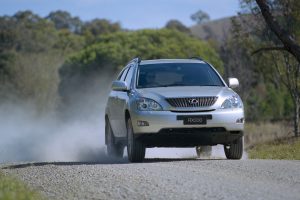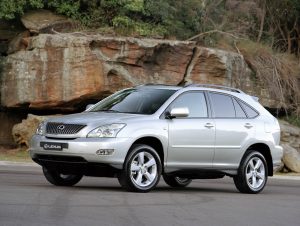Recalls: Lexus XU30 RX
Overview
Manufacturers, or importers, issue recalls for defects or faults which have the potential to cause injury. Generally, manufacturers will inform the original buyers if their vehicle is subject to a recall and of the steps required to remedy the defect or fault. Please note that the recalls below (if any) are for Australian-delivered vehicles only. Furthermore, the number of recalls should not be taken as an indication of a model’s reliability or its safety more generally.
Recalls: Lexus XU30 RX
- In December 2004, a recall was issued for Lexus XU30 RX models produced from 2003 to 2004 due to a condition in which the stop lamp became inoperative due to silicon oxide being generated on the surface of the contact point (PRA 2004/7411).
- In October 2010, a recall was issued for Lexus RX 330 models manufactured from 10 February 2003 to 31 October 2005 due to the brake fluid containing insufficient polymers, causing the brake master cylinder rear rubber seal to become dry and curl during brake application. This could result in brake fluid leaking from the rear of the brake master cylinder, causing a low level of brake fluid and the warning light to illuminate. If operated in this condition, brake pedal feel could change and braking performance could degrade over time. Owners were to contact their dealership for inspection and replacement of the rear rubber cup of the brake master cylinder. The recalled vehicles had VINs in the range JTJ HA31U# 00001045 to 00101881 (PRA 2010/12082).
- In June 2011, a recall was issued for LExus RX 400h models produced from 1 August 2006 to 7 August 2006 due to inadequate soldering of transistors on the control boards located in the inverter assembly. The current flows created by high-load driving could cause the transistors to sustain heat damage. If this occurred, warning lights would be displayed on the instrument panel and the vehicle would generally enter a fail-safe driving mode. In the worse case, the power supply fuse may open circuit, resulting in the hybrid system stopping whilst the vehicle was being driven. The recalled vehicles had VINs in the range JTJ HW31U# 0001093 to JTJ HW31U# 02007900 (PRA 2011/12709).
- In November 2011, a recall was issued for Lexus RX 330 models produced from 1 June 2004 to 31 March 2005 due to the insufficient application of an adhesive agent between the outer ring and torsional rubber damper of the crankshaft pulley – this could cause abnormal noises or sudden illumination of the of the charging system warning light. In rare cases, the belt for the power steering pump could become detached from the pulley, resulting in a sudden and unexpected increase in the amount of steering effort required. The recalled vehicles had VINs in the range JTJ HA31U# 00122971 to JTJ HA31U# 00221475 (PRA 2011/12898).
- In September 2013, a recall was issued for Lexus XU30 RX 400h vehicles that were manufactured from June 2006 to December 2008. In these vehicles, variations in the circuit characteristics of the Intelligent Power Module (IPM) could produce higher operating temperatures and internal solder degradation. Eventually, heat damage to the IPM would cause warning lights on the instrument panel to illuminate; the vehicle would also enter a fail-safe mode which reduced driving power and limited the vehicle to short distances. In limited instances, the fuse of the power supply circuit could operate, causing the hybrid system to shut down and the vehicle to stop whilst being driven. The affected vehicles were in the VIN range JTJ HW31U # 02007302 to JTJ HW31U # 02867547 (PRA 2013/13732).
Problems and faults: Lexus XU30 RX
Overview
This section identifies potential problems, causes and fixes based on the experiences of owners and repairers, online sources and technical service bulletins. This information is provided solely for reference purposes and AustralianCar.Reviews recommends that only properly qualified persons carry out repairs or modifications. Furthermore, the number of items below should not be taken as an indicator of a model’s reliability or the frequency with which they may occur.
To report a problem or fault to the AustralianCar.Reviews team, please use the Contact Us form. Note that AustralianCar.Reviews does not offer advice on automotive problems or disputes; such enquiries will not receive a reply. For vehicles purchased from dealers after 1 January 2011, please see our Australian Consumer Law fact sheet.
2006-08 Lexus XU30 RX 350: VVT-i oil hose leak
In August 2014, Toyota USA issued its extended ‘Limited Service Campaign’ (LSC) 90K for Lexus XU30 RX 350 vehicles vehicles that had 3.5-litre 2GR-FE V6 engines and were manufactured from January 2006 to August 2008. In these vehicles, the rubber portion of the oil supply hose for the VVT-i actuator could develop a pinhole and exposure to small amounts of corrosive gases from the positive crankcase ventilation (PCV) system may cause this pinhole to expand and oil to leak. If this occurred, the engine noise may be ‘abnormal’ and the oil pressure light may illuminate.
As part of LSC 90K, the VVT-i oil hose was to be replaced with a ‘newly designed’ hose at no charge to owners. Vehicle owners could participate in the service campaign until 31 December 2021.
Lexus XU30 RX 330: front brake vibration
In June 2004, Lexus issued Technical Service Information Bulletin BR004-04 for 2004 model year Lexus RX 330 vehicles. In these vehicles, the driver may experience front brake vibration. New front brake rotors (discs) were developed to improve this condition.
Lexus XU30 RX 330: excessive sulfur odour
In September 2005, Lexus issued Technical Service Information Bulletin EG013-05 for 2004-05 model year Lexus RX 330 vehicles. In stop-and-go driving and under heavy acceleration, these vehicles may produce an excessive sulphur odour. To reduce this odour, a new catalytic converter was introduced (parts numbers 17420-0A270 and 17420-20350 were to be replaced with part number 17420-0A280).
Lexus XU30 RX 330: gear shifting enhancement
In August 2006, Lexus issued Technical Service Information Bulletin TC005-03 for 2004 and 2005 model year Lexus XU30 RX 330 vehicles. For these vehicles, a new calibration was developed for the engine control module (ECM) to improve gear shift feel. Improvements included:
- Reduced downshift lag when accelerating at speeds from 16 to 32 km/h;
- Less gear hunting when driving on/off accelerator pedal at 32 km/h to 48 km/h; and,
- Improved response rate during heavy acceleration from a stop.
Lexus XU30 RX 330: door mirror operation
In March 2007, Lexus issued Technical Service Information Bulletin EL004-07 for 2004-05 model year Lexus XU30 RX 330 vehicles. In these vehicles, one or both of the outer rear view mirrors may not operate smoothly from the switch. To fix, an updated door mirror actuator was introduced.
Lexus XU30 RX 350: A/C light blinking
In October 2006, Lexus issued Technical Service Information Bulletin AC004-06 for 2007 model year Lexus RX 350 vehicles with VINs preceding JTJ HK31U # 72013500. In these vehicles, the air conditioning light may blink and/or a ‘Check A/C System’ error message may appear on the multi-information display. Production changes were subsequently made to the A/C amplifier to prevent this concern (part no. 88650-0E021).
Lexus XU30 RX: sticky/melting dashboard
For Lexus XU30 RX vehicles, the polymer which the dashboard is made from may degrade due to sunlight/heat and humidity. As a result, the dashboard surface may:
- Become sticky to the touch; and,
- Appear shiny and reflect more light, causing increased glare and impaired visibility.
The driver may also experience a ‘chemical’ smell.
In 2014, Toyota and Lexus USA initiated Warranty Enhancement Program ZE6 for the following vehicles:
- 2004-06 Lexus RX 330;
- 2005-08 Lexus RX 400h; and,
- 2007-09 Lexus RX 350.
The specific condition covered by the Warranty Enhancement Program was a cracked and/or sticky/melting dashboard in a covered (i.e. non-convertible) vehicle as a result of heat or humidity. If the condition was verified, the repair would be performed in accordance with the applicable Technical Service Bulletin. For the Warranty Enhancement Program,
- The ‘Primary Coverage’ extended the warranty until 31 May 2017 regardless of mileage or date of first use of the vehicle; and,
- The ‘Secondary Coverage’ supplemented the Primary Coverage for some owners by extending the warranty for ten (10) years from the date of first use of the vehicle, regardless of mileage.
Within Australia, there have been instances of owners having had their dashboards replaced free of charge.
Lexus XU30 RX: windscreen rattle
In May 2010, Lexus issued Lexus Service Bulletin L-SB-0090-08 Rev 1 for Lexus XU30 RX 330, RX 350 and RX 400h vehicles. In these vehicles, a creaking, ticking or rattling noise may be heard at the top or bottom of the windscreen. According to the service bulletin, this may be attributable to:
- The two windscreen stoppers that are bottom to the top of the windscreen; or,
- The windshield retainers which are bonded to the lower edge of the windscreen.
Lexus XU30 RX: cargo cover latch rattle
In April 2007, Lexus issued Technical Service Information Bulletin NV001-07 for the following vehicles:
- 2004-06 model year Lexus RX 330 vehicles;
- 2006-07 model year Lexus RX 400h vehicles; and,
- 2007 model year Lexus RX 350 vehicles.
In these vehicles, a rattling noise may be heard from the rear of the vehicle when going over bumps. According to the service bulletin, this noise was due to a lack of insulation and excessive clearance between the tonneau cover locks and the back door trim spacers. To fix, the back door trim spacer on both the left and right sides was to be replaced.
Problems and faults: Lexus XU30 RX
- The air conditioning may become less effective and produce less airflow after driving for 90 minutes due to the evaporator icing up; a wiring harness adapter should resolve the problem.
- The air conditioning warning light may blink due to failure of the amplifier.
- The ‘check engine’ light may illuminate due to a vacuum leak which enables air past the pivot for the intake air control valve.
- If the engine does not start in cold or sub-zero temperatures, a revised fuel pump sub-tank assembly may be required to fix.
- Popping or scratching noises from the rear door indicates that the power door unit needs to be replaced.
- If the engine feels like it is surging (i.e. speeding up and slowing down) at cruising speeds, the engine control module may need to be reprogrammed.
- Transmission fluid may leak from the oil seal on the right side of the transfer case; an improved oil seal was available to rectify this problem.
- The automatic rear hatch may begin opening only to reverse and close; if so, the gas support struts are likely weak and require replacement.
- If the ‘automatic up’ function for the window ceases to operate, the switch must be replaced – a revised switch was subsequently released.
- Some early models experienced oil leaks at the timing cover.




